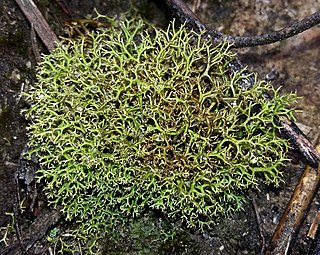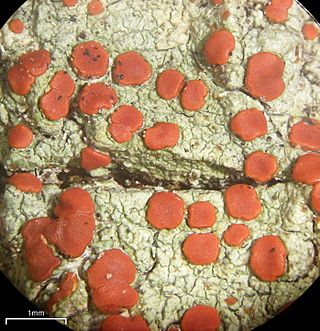
The Icmadophilaceae are a family of lichen-forming fungi in the order Pertusariales. The family was circumscribed in 1993 by the mycologist Dagmar Treibel. It contains 9 genera and 35 species.

Cladia is a genus of lichen-forming fungi in the family Cladoniaceae. Cladia species have a crustose or squamulose (scaly) primary thallus and a fruticose, secondary thallus, often referred to as pseudopodetium. The type species of the genus, Cladia aggregata, is widely distributed, occurring in South America, South Africa, Australasia and South-East Asia to southern Japan and India. Most of the other species are found in the Southern Hemisphere.
Kantvilasia is a lichen genus in the family Pilocarpaceae. This is a monotypic genus, containing the single species Kantvilasia hians.

Ramboldia is a genus of lichen-forming fungi in the family Ramboldiaceae. The genus was circumscribed in 1994 by Gintaras Kantvilas and John Alan Elix. It was emended in 2008 by the inclusion of Pyrrhospora species containing the anthraquinone russulone in their apothecia and having a prosoplectenchymatous exciple. The family Ramboldiaceae was circumscribed in 2014 to contain the genus.
Menegazzia inactiva is a species of foliose lichen found in New Zealand and Australia. The type locality of this species is in Tasmania, south of Arthur River near Sumac Road. The species was discovered on Tasmannia lanceolata in rainforest habitat. The type specimen is held at the herbarium of the Tasmanian Museum and Art Gallery.
Menegazzia minuta is a rare species of foliose lichen that is endemic to Tasmania, Australia. It was scientifically described as a new species in 1987 by lichenologists Peter James and Gintaras Kantvilas. The type specimen was collected by the second author south of Arthur River, where the lichen was found in a rainforest growing on twigs of leatherwood. The species epithet minuta refers to the small size of its thallus. Menegazzia minuta contains protolichesterinic acid, a lichen product that helps to distinguish it from the similar species Menegazzia eperforata, which instead contains stictic acid and related compounds. In a 2012 publication, Kantvilas called M. minuta "one of Tasmania's rarest lichens", characterised by a "glossy olive-brown thallus of minute, spidery lobes, densely beset with lobule-like isidia".
Tasmidella is a lichen genus in the family Ramalinaceae. Circumscribed by Gintaras Kantvilas, Josef Hafellner, and John A. Elix in 1999, it contains the single species Tasmidella variabilis, found in Tasmania. It is distinguished from the closely related genus Megalaria by having simple spores with a layered wall.

Mycoblastus is a genus of crustose lichens in the family Tephromelataceae. Members of the genus are commonly called blood lichens.

Hertelidea is a genus of crustose lichens in the family Stereocaulaceae. Characteristics of the genus include carbon-black ring or outer margin (exciple) around the fruit body disc (apothecium), eight-spored, Micarea-type asci and mostly simple, hyaline ascospores that lack a transparent outer layer. Hertelidea species mostly grow on wood, although less frequently they are found on bark or soil. While the type species, Hertelidea botryosa, has a widespread distribution, most of the other species are found only in Australia.
Gintaras Kantvilas is an Australian lichenologist, who earned his Ph.D in 1985 from the University of Tasmania with a thesis entitled Studies on Tasmanian rainforest lichens. He has authored over 432 species names, and 167 genera in the field of mycology.
Amandinea devilliersiana is a species of crustose lichen in the family Caliciaceae, and found in South Australia. It was first described in 2013 by Australian lichenologists Jack Elix and Gintaras Kantvilas from a specimen collected on a granite boulder near the seashore in South Australia. The species epithet, devilliersiana, honours Brigitte de Villiers. Specimens used for the description came from both Tasmania and South Australia.
Punctelia transtasmanica is a species of foliose lichen in the family Parmeliaceae. It is found in Australasia.
Punctelia pseudocoralloidea is a species of foliose lichen in the family Parmeliaceae. It is found in Australia, where it grows on bark and on wood.

Megalospora is a genus of lichen-forming fungi in the family Megalosporaceae.
Ramboldia blastidiata is a species of saxicolous (rock-dwelling) and crustose lichen in the family Lecanoraceae. Found in Australia, it was formally described as a new species in 2007 by lichenologists Gintaras Kantvilas and John Elix. The type specimen was collected by the first author from the western slopes of Strzelecki Peaks on Flinders Island (Tasmania) at an altitude of 150 m (490 ft); here, in dry sclerophyll forest, it was found growing on a granite boulder. The lichen forms pale grey-green, olive-green to dull olive-brown crust-like patches up to 30 cm (12 in) wide. The authors suggest that it is widespread in temperate Australia and Tasmania, but not commonly collected. Others saxicolous lichens that it usually grows with include Ramboldia petraeoides, Lecanora farinacea, Xanthoparmelia mougeotina, and species from the genera Buellia and Rhizocarpon. The specific epithet blastidiata refers to the presence of blastidia, which are vegetative propagules that contain mycobiont and photobiont and are produced by yeast-like budding.
Xanthoparmelia canobolasensis is a lichen which belongs to the Xanthoparmelia genus. It is found in the Australian states of New South Wales and Tasmania. Although not currently endangered it appears to fulfill the criteria under the Tasmanian Threatened Species Protection Act 1995.
Chrysothrix palaeophila is a rare species of corticolous (bark-dwelling) lichen in the family Chrysotrichaceae. It is endemic to Tasmania, Australia. The lichen grows in bark fissures that rarely have other lichens. It has an immersed thallus that slightly bleaches the bark it grows on, and tiny apothecia that are densely covered with yellow to yellow-green pruina.
Xanthoparmelia morrisii is a species of saxicolous (rock-dwelling), foliose lichen in the family Parmeliaceae. Found in Tasmania, Australia, it was formally described by lichenologist John Alan Elix and Gintaras Kantvilas in 2009. The species epithet honours the Tasmanian botanist Dennis Ivor Morris.
Xanthoparmelia subvicariella is a species of saxicolous (rock-dwelling), foliose lichen in the family Parmeliaceae. Found in Tasmania, Australia, it was formally described by lichenologist John Alan Elix and Gintaras Kantvilas in 2009. The species epithet refers to the similarity this species has with Xanthoparmelia vicariella.
Xanthoparmelia freycinetiana is a species of saxicolous (rock-dwelling), foliose lichen in the family Parmeliaceae. Found in Tasmania, Australia, it was formally described by lichenologists John Alan Elix and Gintaras Kantvilas in 2009. The species epithet refers to Freycinet Peninsula, the type locality.





